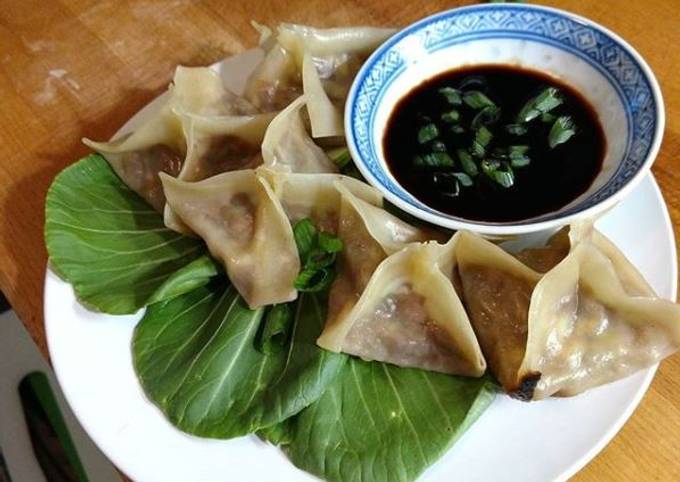
Hello everybody, it is Brad, welcome to our recipe site. Today, I’m gonna show you how to make a distinctive dish, pot-stickers (gyoza). It is one of my favorites food recipes. This time, I am going to make it a bit unique. This will be really delicious.
Heat oil in a heavy skillet over medium-high heat. Gyoza, or Japanese potstickers, originated in China. The pan-fried dumplings were inspired by the rich dumpling history in Chinese cuisine. The most popular type of gyoza are filled with juicy, savory ground pork and cabbage along with flavorful ingredients like ginger and soy sauce.
Pot-stickers (Gyoza) is one of the most well liked of recent trending foods in the world. It is appreciated by millions every day. It’s easy, it is quick, it tastes delicious. Pot-stickers (Gyoza) is something which I’ve loved my entire life. They are fine and they look wonderful.
To begin with this particular recipe, we have to prepare a few components. You can cook pot-stickers (gyoza) using 14 ingredients and 4 steps. Here is how you cook that.
The ingredients needed to make Pot-stickers (Gyoza):
- Make ready Some won-ton wrappers (don't be a jackass, just buy them)
- Take about 1/2 a pound of any meat you want (ground or chopped fine) (if using whole beef primal/subprimal, I recommend cooking ahead of time)
- Make ready Baby Bok choy, chopped fine
- Get 3-4 cloves garlic minced
- Prepare 1 big knob of ginger, diced fine
- Take Juice of a lime
- Prepare 1 spoon sambal (garlic-chili paste)
- Prepare 1/2 bunch chopped green onion
- Prepare 1 glug of soy sauce, mirin, rice vinegar
- Take light drizzle of toasted sesame oil
- Take Pepper, red pepper flake
- Take vegetable oil
- Make ready 2-3 tablespoons water
- Take 1 knob butter
Japanese gyoza do have some general, subtle differences from potstickers. They are usually made from pre-fabricated wrappers that are thinner, smaller, and more delicate, and the filling is more finely textured. Gyoza are usually smaller than a potsticker, about one to two bites. Although they're prepared in much the same manner as.
Steps to make Pot-stickers (Gyoza):
- Combine all of the ingredients with the exception of water, oil, butter and the won ton wrappers (smartass). Set aside in the fridge covered in plastic (this can be done ahead of time)
- Place a small spoonful (1 teaspoon-ish?) of the filling in the center of a won ton wrapper. Dip your finger in some warm water and run along the edges of the wrapper. You don't want it sopping wet, just sticky. Bring up all of the corners, working in a counter-clockwise fashion (it doesn't matter, thats just how I do it) and pinch the seams together, ensuring you press out all of the air, and the pot-stickers are sealed completely. Set these aside under a damp kitchen towel until ready.
- Bring a small drizzle of oil to temperature over medium/medium-high heat and place in the pot-stickers. Let fry until the bottoms begin to turn golden brown. Once achieved, dump in approximately 2-3 tablespoons of water and immediately cover. Steam for 3 minutes.
- Blot out any excess water and quickly add a bit of butter. Fry for a bit longer, continually checking the bottoms of the won tons to ensure you are not burning them (ride the heat throttle to compensate). Once they are fried to your liking, remove to a paper towel lined plate and serve with soy sauce and more sliced green onion!
Gyoza are usually smaller than a potsticker, about one to two bites. Although they're prepared in much the same manner as. They go by many names: Potstickers, gyoza, japanese pan fried dumplings. At the end of the day they are delicious dumplings packed with loads of asian flavors, pork, and then pan fried for a crispy bottom. Japanese gyoza generally refers to pan-fried yaki-gyoza, but steamed mushi-gyoza and boiled sui-gyoza are also popular.
So that’s going to wrap this up for this special food pot-stickers (gyoza) recipe. Thanks so much for your time. I’m sure you will make this at home. There is gonna be more interesting food at home recipes coming up. Don’t forget to bookmark this page on your browser, and share it to your loved ones, colleague and friends. Thanks again for reading. Go on get cooking!